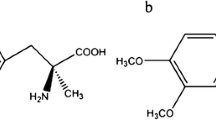Abstract
A simple and precise method for chiral separation of tryptophan enantiomers using high performance liquid chromatography with aligand exchange mobile phase was developed. Chiral separation was performed on a conventional C18 column, using a mobile phase that consisted of a water-methanol solution (88∶12, v/v) containing 10 mmol/Ll-leucine and 5 mmol/L copper sulfate as a chiral ligand additive at a flow rate of 1.0 mL/min. This method allowed baseline separation of two enantiomers with a resolution of 1.84 in less than 30 min. The effect of various conditions, including concentration, type of ligand, organic modifier, pH, flow rate, and temperature, on enantioseparation were evaluated and chiral recognition mechanisms were investigated. Thermodynamic data (ΔΔH and ΔΔS) obtained by van't Hoff plots revealed that enantioseparation is an enthalpy-controlled process.
Similar content being viewed by others
References
Cho, B. K., J. H. Seo, J. Kim, C. S. Lee, and B. G. Kim (2006) Asymmetric synthesis of unnatural L-amino acids using thermophilic aromatic L-amino acid transaminase.Biotechnol. Bioprocess Eng. 11: 299–305.
Peter, A., G. Torok, D. W. Armstrong, G. Toth, and D. Tourwe (2000) High-performance liquid chromatographic separation of enantiomers of synthetic amino acids on a ristocetin A chiral stationary phase.J. Chromatogr. A 904: 1–15.
Taylor, D. R. and K. Maher (1992) Chiral separations by high-performance liquid chromatography.J. Chromatogr. Sci. 30: 67–85.
Young, S. N. (1996) Behavioral effects of dietary neurotransmitter precursors: basic and clinical aspects.Neurosci. Biobehav. Rev. 20: 313–323.
Capuron, L., A. Ravaud, P. J. Neveu, A. H. Miller, M. Maes, and R. Dantzer (2002) Association between decreased serum tryptophan concentrations and depressive symptoms in cancer patients undergoing cytokine therapy.Mol. Psychiatry 7: 468–473.
Riemann, D., B. Feige, M. Hornyak, S. Koch, F. Hohagen, and U. Voderholzer (2002) The tryptophan depletion test: impact on sleep in primary insomnia—a pilot study.Psychiatry Res. 109: 129–135.
Hughes, J. H., P. Gallagher, and A. H. Young (2002) Effects of acute tryptophan depletion on cognitive function in euthymic bipolar patients.Eur. Neuropsychopharmacol. 12: 123–128.
Chen, Z., K. Okamura, M. Hanaki, and T. Nagaoka (2002) Selective determination of tryptophan by using a carbon paste electrode modified with an overoxidized polypyrrole film.Anal. Sci. 18: 417–421.
Fiorucci, A. R. and E. T. G. Cavalheiro (2002) The use of carbon paste electrode in the direct voltammetric determination of tryptophan in pharmaceutical formulations.J. Pharm Biomed. Anal. 28: 909–915.
Liao, Y., W. Wang, and B. Wang (1999) Building fluorescent sensors by template polymerization: The preparation of a fluorescent sensor for L-tryptophan.Bioorg. Chem. 27: 463–476.
Liu, F., X. Liu, S. C. Ng, and H. S. O. Chan (2006) Enantioselective molecular imprinting polymer coated QCM for the recognition of L-tryptophan.Sens. Actuators B 113: 234–240.
Oshite, S., M. Furukawa, and S. Igarashi (2001) Homogeneous liquid-liquid extraction method for the selective spectrofluorimetric determination of trace amounts of tryptophan.Analyst 126: 703–706.
Reynolds, D. M. (2003) Rapid and direct determination of tryptophan in water using synchronous fluorescence spectroscopy.Water Res. 37: 3055–3060.
Tcherkas, Y. V., L. A. Kartsova, and I. N. Krasnova (2001) Analysis of amino acids in human serum by isocratic reversed-phase high-performance liquid chromatography with electrochemical detection.J. Chromatogr. A 913: 303–308.
Alegria, A., R. Barbera, R. Farre, M. Ferreres, M. J. Lagarda, and J. C. Lopez (1996), Isocratic highperformance liquid chromatographic determination of tryptophan in infant formulas.J. Chromatogr. A 721: 83–88.
Hanko, V. P. and J. S. Rohrer (2002) Direct determination of tryptophan using high-performance anionexchange chromatography with integrated pulsed amperometric detection.Anal. Biochem. 308:204–209.
Lee, J. W., C. H. Lee, and Y. M. Koo (2006) Sensitivity analysis of amino acids in simulated moving bed chromatography.Biotechnol. Bioprocess Eng. 11: 110–115.
Yan, H. and K. H. Row (2006) Molecularly imprinted monolithic stationary phases for liquid chromatographic separation of tryptophan andN-CBZ-phenylalanine enantiomers.Biotechnol. Bioprocess Eng. 11: 357–363.
Altria, K. D., P. Harkin, and M. G. Hindson (1996) Quantitative determination of tryptophan enantiomers by capillary electrophoresis.J. Chromatogr. B 686: 103–110.
Kim, K. and K. Lee (2000) Chiral separation of tryptophan enantiomers by liquid chromatography with BSA-silica stationary phase.Biotechnol. Bioprocess Eng. 5: 17–22.
Ryu, J. W., H. S. Chang, Y. K. Ko, J. C. Woo, D. W. Koo, and D. W. Kim (1999) Direct chiral separation of tryptophan analogues using heptakis(3-O-methyl)-β-cyclodextrin-bonded stationary phase in reversed-phase liquid chromatography.Microchem. J. 63: 168–171.
Garnier, F., J. Randon, and J. L. Rocca (2000) Comparison of tryptophan interactions to free and grafted BSA protein.Talanta 51: 1001–1007.
Nakamura, M., S. Kiyohara, K. Saito, K. Sugita, and T. Sugo (1998) Chiral separation of DL-tryptophan using porous membranes containing multilayered bovine serum albumin crosslinked with glutaraldehyde.J. Chromatogr. A 822: 53–58.
Slama, I., E. Jourdan, C. Grosset, A. Ravel, A. Villet, and E. Peyrin (2003) Role of the vancomycin-ristocetin heterodimerization on the enantioselectivity of D.L-tryptophan and D,L-dansyl tryptophan.J. Chromatogr. B 795: 115–121.
Author information
Authors and Affiliations
Corresponding author
Rights and permissions
About this article
Cite this article
Yan, H., Row, K.H. Optimum operational conditions for chiral separation of tryptophan enatiomers using ligand exchange liquid chromatography. Biotechnol. Bioprocess Eng. 12, 235–241 (2007). https://doi.org/10.1007/BF02931098
Received:
Accepted:
Issue Date:
DOI: https://doi.org/10.1007/BF02931098




